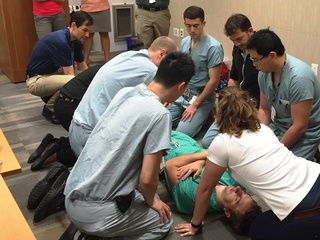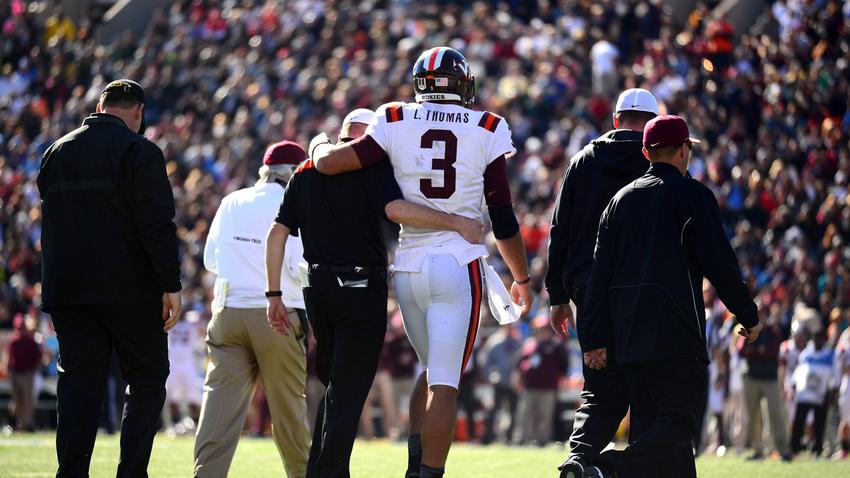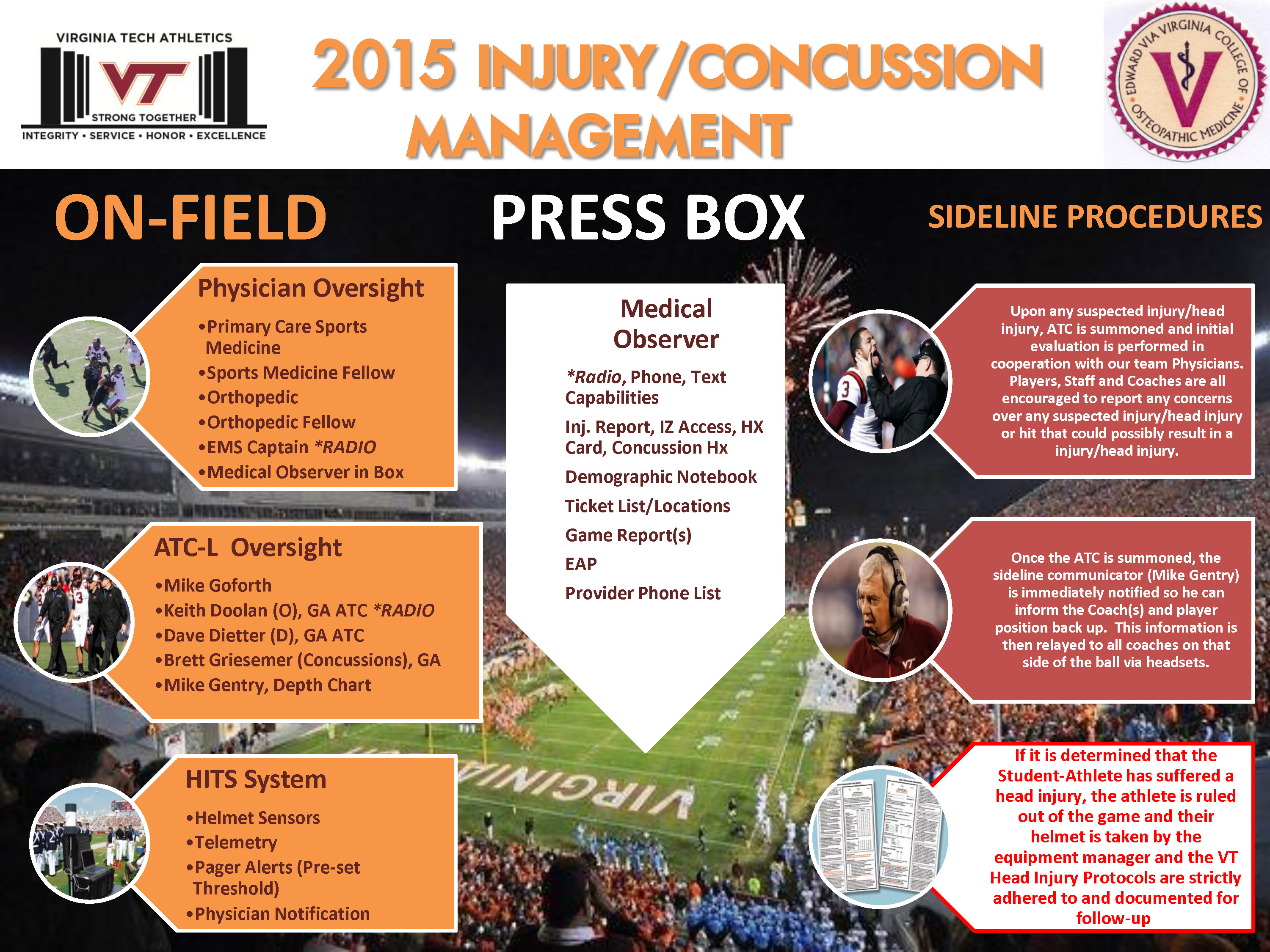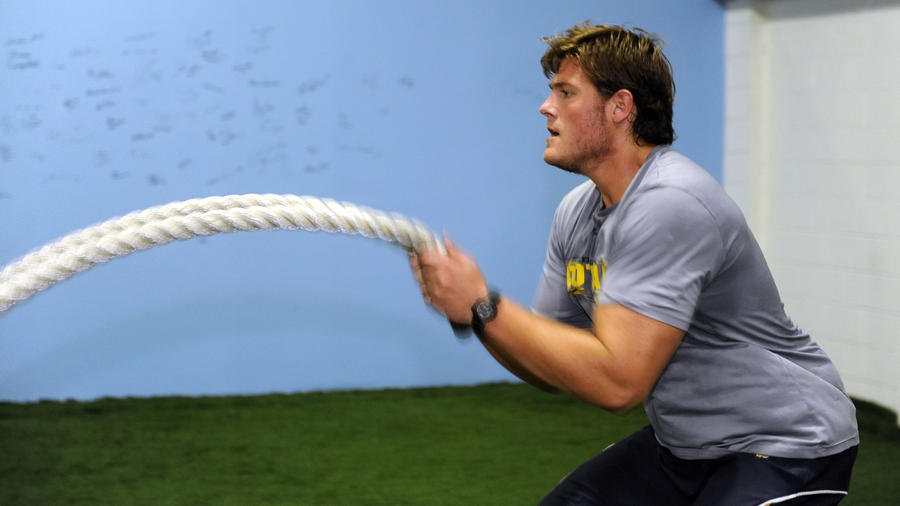
If you just started following California rugby recently, you’ve seen a lot. Since 2013, the Golden Bears have racked up an overall record of 56-6 (.903) in 15s and won three straight national collegiate championships in Olympic 7s, the version of the sport going into the next Summer Games.
But Cal rugby goes back much further, to its 1882 origin, a history that has accrued staff with remarkable longevity. Jack Clark, in his 33rd year, is only the sixth head coach in the team’s 134-year history.
When the Bears won their first 7s title at the 2013 Collegiate Rugby Championship and the team performed the unparalleled honor of raising one of its own onto the players’ shoulders to celebrate, it was the athletic trainer, David Stenger, who was raised high to recognize his dedicated skill and service as he headed into retirement after 40 years of service.
But who would be taking Stenger’s place the following season as the lead presence in the training room, on the sideline and pitch, at every training session and on every road trip as the Rugby Bears go through the rigors of one of the most demanding sports on the planet in representation of their University and commitment as student-athletes to the No. 1 public institution in the world?
What kind of person would it take to fill the shoes of such a legend?

Those shoes have been filled and that mantle passed to Brynn Lewis MS, ATC, a former varsity collegiate softball player who came to Cal from Seattle by way of Brooklyn, N.Y., where she earned her Bachelor and Masters degrees while competing for Long Island University. Since the start of the 2013-14 year, Lewis has managed the athletic training needs of almost 70 male student-athletes with rugby, coordinating their care with the world-class staff that spans from Witter Rugby Field down to the Simpson Center for Student-Athlete High Performance, its training quarters, and by extension into the operating rooms and throughout the daily lives of members of the team.
Lewis actually hails from Woodinville, Wash., where she played three seasons of varsity softball at Woodinville High School before going to LIU, where she remained a solid hitter and infielder, and became a member of the Northeast Conference Academic Honor Roll. Soon after she came to Cal in 2011 and started working with Stenger in both men’s soccer and rugby, Lewis saw the legacy that he had created.

“I was lucky my first year, when I was an intern under Dave Stenger,” she said. “He had already cultivated this team and this system within the training room and with the coaches. I was able to learn from him and see how he operated in that system and figure out the role that he took on and figure out ways to problem solve and how to communicate best with the athletes and the coaches. I took a lot of tips and I did a lot of watching and listening with him to learn different strategies to handle situations and to be the manager within the system in the training room for the athletes.”
Stenger recalled how Lewis put forth the effort to earn her place on the team: “She worked hard, was very knowledgeable in rehab, learned the game well, was very concerned about the players and was accepted well by the players themselves.”
As they joined forces throughout the year to administer to their teams’ needs, Stenger also offered Lewis his advice on dealing with a high-performance culture such as Cal rugby: “I told Brynn that she shouldn’t feel put upon by being challenged, because that’s the goal of what we’re doing: we’re challenging each other to get better.”
Having completed two years in her new position capped by the 2015 national 7s title at the CRC, Lewis has risen to the challenge. Said head coach Jack Clark, “Brynn has been terrific in her role. She has taken the reins from a legendary Cal athletic trainer and learned very quickly. What I need is expert level information and timely communication, and she delivers.”
As a former collegiate varsity athlete whose LIU team went to the NCAA Regional Finals her senior year, Lewis was able to understand the mindset and command the respect from student-athletes and staff who knew that she had walked in the players’ shoes, too.
“I’ve been on a team and understand the demands of time, the responsibility and the pressure,” Lewis explained. “The players appreciate that I know what comes with having to make a game-time decision, what goes into preparing for games and a season, and that I have that experience.”
It was her point of view as an injured athlete that opened Lewis’ eyes to the professional field of athletic training. “I tore my ACL in high school when I had just turned 16, and was able to come back from that and still get recruited,” she recalled. During her freshman year she suffered another knee injury and “that’s how I learned about the profession of athletic training, because I came into college wanting to be a physical therapist, and then I injured myself, got to know my athletic trainer and realized, this is what I want to do, I want to work with athletes and I want to work with people at a high level. Over time it took on my interest as a student and not just as an athlete.”
Fortunately for Lewis, at LIU she was already at an accredited program and was able to progress from her Bachelors curriculum through a Master of Science in Sports Science & Athletic Training in five years. She then passed the boards for national certification and became a Certified Athletic Trainer. Her first hired position was as a two-year intern at the University of California working with track & field and cross country, and women’s water polo.
Going into her second year on staff, Lewis said, “I wanted something completely different, something challenging. A new position opened up to assist Dave Stenger with men’s soccer and rugby, and no one had really done that yet. I wanted to do it because I feel like the best way to learn is to get out of your comfort zone.”
What Lewis found in the Cal rugby team was a culture in which nothing is ever taken for granted.
“Their status is known as a team that values accountability,” she said. “When I stared working with them, that was always something that Dave ingrained in me, that I should expect a lot from the guys because a lot is expected of them from the coaches and you should keep a system all the way across the board so that when they walk into the training room, it’s not like that all of a sudden that goes away. It’s consistent in the training room, the classroom and on the field with their coaches. That was ingrained not just from Dave to me but also by listening to coach Clark’s team communications. I knew that would be the expectation all the way through.”
With rugby, Lewis soaked up everything she could learn like a sponge – not the proverbial magic sponge of rugby lore, which cures everything and nothing – but like a dedicated professional intent on learning best practices from a proven product while offering her own input to keep getting better. The fact that Stenger would be retiring and his head rugby position come open would come as a shock to her.
“I didn’t know until the very end of the season that he was going to be leaving. He was the only athletic trainer coach Clark had ever had at Cal. That is a huge role to step into. As we went through the interview process to see if I was the right fit, coach asked me about the things I saw that worked here and where I saw room to improve them. I have tried to find ways to enhance the things we already have, techniques and methods of communications, trying to improve a system that was already very good.”
Lewis knew that Hall of Fame head coach Jack Clark was a two-sport athlete at Cal and a national team player before his coaching career began. She knew that working with him would entail “high expectations for team and staff and self. That’s somewhat daunting to come into, but it’s also nice, because I know that he trusts me enough to put me in that role and he has high expectations for me, which is intimidating but also very satisfying.”
Working with Clark and Tom Billups, whose coaching extends to the team’s strength & conditioning program, has been a rewarding and collaborative process for Lewis. “We talk on a daily basis, multiple times a day. We can talk about everything and it’s always a team effort to talk about every athlete has a plan, has a system, and we’re all on the same page trying to get them to meet their goals.”
“In our design,” added Clark, “Brynn works directly with Tom and our physicians to knit our strength & conditioning, physical and medical assessments, preventative athletic training and rehab efforts into a seamless, coordinated function.”
While the coaches may be perceived as father figures, Lewis can at time sense an invitation to be a sister and a mother to the players. “Some of the guys from out of the country that don’t have someone to go to with certain questions, little things like renting a house, signing a lease, taxes,” she said. “When we get to the point where they’re asking me those types of questions, I try not to become too much of a mother. That would be a big role to 70-something guys. But when they come in the training room, we talk about their injuries and the real world as well.”
Lewis may never have left her nation’s shores for school, but moving from the Pacific Northwest to the East Coast for college does give her some street cred with the students who feel like fish out of water far from home. And when recovering student-athletes are using the underwater treadmills and other resources at the Simpson Center for Student-Athlete High Performance, everyone takes comfort in knowing they have the best care a team can offer.
“We’re really lucky to have the high-performance center. Especially for people returning back from a surgical injury, the resources there are huge” Lewis said. “But I try not to get caught up in the bells and whistles. At a previous time, we didn’t have all those things and people still came back from injuries. So we use not just these latest tools but other ways we can get them back to functional movement and progress them back into sport.”
Lewis is newly married to Patrick Fuller, a fellow athletic trainer whose mutual expertise offers Lewis a valuable sounding board and support network at home. “He understands the time commitment and relationship you create with the team, the players and the coaches, so when I have to work weekends, he’ll come watch the game, we’ll find a way to grab a meal together,” she said. “It’s also very valuable that I can come home and bounce ideas off him. He’ll say, ‘I never would have thought of that,’ and then he’ll come home with a story from work that helps me see something else in a totally different way.”
The United States’ qualification to vie for medals at the 2016 Sumer Olympics has also made Lewis see rugby is a different way, knowing that today’s athletes have an opportunity to aspire for a spot on the U.S. National Teams.
“It’s exciting to see someone come in as a freshman. I think back to when I first got to New York as a wide-eyed kid, asking a bunch of questions, trying to figure things out,” Lewis said. “People come in here and come into themselves, successful men entering the world, and it’s really exciting to see that transformation and to know their goals can be met at the highest level – the Olympic level – is really exciting.”
Lewis and Stenger still have lunch every month or so, and Brynn said, “He’ll still have little tips and tricks that he’s been holding back on and he’ll release to me.”
Stenger called their ongoing lunches “a fun opportunity for both of us to keep talking about how we did things in the past and for her to form her plans for how she can do things in the future.”
Lewis remains grateful to everyone, especially to her predecessor and to the rugby coaches, for their help as she gains her footing as the next athletic trainer for the Rugby Bears. “It’s a huge honor because I know how difficult it is to remain in a college setting for so long,” Lewis said. “For Dave to become my mentor and coach Clark to give me this opportunity in a system that is so well organized, those were definitely huge compliments.”
Compliments are nice, but there are student-athletes who need her help. Brynn Lewis is already off to tackle the next task of the day in her vital role for Cal rugby.
ORIGINAL ARTICLE:
http://www.calbears.com/ViewArticle.dbml?DB_OEM_ID=30100&ATCLID=210236591












